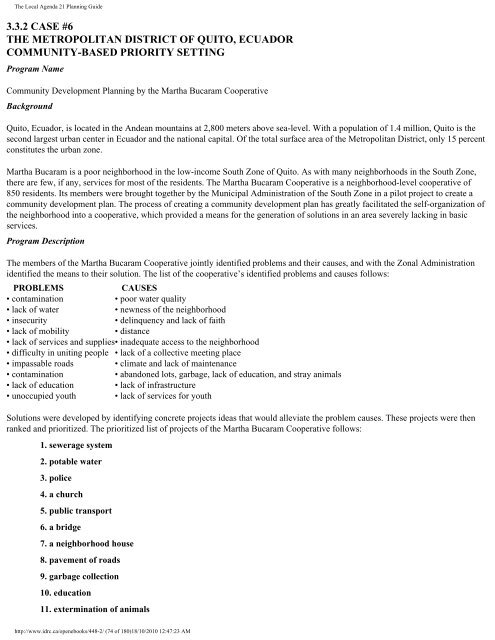The Local Agenda 21 Planning Guide - Democrats Against UN ...
The Local Agenda 21 Planning Guide - Democrats Against UN ...
The Local Agenda 21 Planning Guide - Democrats Against UN ...
You also want an ePaper? Increase the reach of your titles
YUMPU automatically turns print PDFs into web optimized ePapers that Google loves.
<strong>The</strong> <strong>Local</strong> <strong>Agenda</strong> <strong>21</strong> <strong>Planning</strong> <strong>Guide</strong><br />
3.3.2 CASE #6<br />
THE METROPOLITAN DISTRICT OF QUITO, ECUADOR<br />
COMM<strong>UN</strong>ITY-BASED PRIORITY SETTING<br />
Program Name<br />
Community Development <strong>Planning</strong> by the Martha Bucaram Cooperative<br />
Background<br />
Quito, Ecuador, is located in the Andean mountains at 2,800 meters above sea-level. With a population of 1.4 million, Quito is the<br />
second largest urban center in Ecuador and the national capital. Of the total surface area of the Metropolitan District, only 15 percent<br />
constitutes the urban zone.<br />
Martha Bucaram is a poor neighborhood in the low-income South Zone of Quito. As with many neighborhoods in the South Zone,<br />
there are few, if any, services for most of the residents. <strong>The</strong> Martha Bucaram Cooperative is a neighborhood-level cooperative of<br />
850 residents. Its members were brought together by the Municipal Administration of the South Zone in a pilot project to create a<br />
community development plan. <strong>The</strong> process of creating a community development plan has greatly facilitated the self-organization of<br />
the neighborhood into a cooperative, which provided a means for the generation of solutions in an area severely lacking in basic<br />
services.<br />
Program Description<br />
<strong>The</strong> members of the Martha Bucaram Cooperative jointly identified problems and their causes, and with the Zonal Administration<br />
identified the means to their solution. <strong>The</strong> list of the cooperative’s identified problems and causes follows:<br />
PROBLEMS CAUSES<br />
• contamination<br />
• poor water quality<br />
• lack of water<br />
• newness of the neighborhood<br />
• insecurity<br />
• delinquency and lack of faith<br />
• lack of mobility<br />
• distance<br />
• lack of services and supplies• inadequate access to the neighborhood<br />
• difficulty in uniting people • lack of a collective meeting place<br />
• impassable roads • climate and lack of maintenance<br />
• contamination<br />
• abandoned lots, garbage, lack of education, and stray animals<br />
• lack of education • lack of infrastructure<br />
• unoccupied youth • lack of services for youth<br />
Solutions were developed by identifying concrete projects ideas that would alleviate the problem causes. <strong>The</strong>se projects were then<br />
ranked and prioritized. <strong>The</strong> prioritized list of projects of the Martha Bucaram Cooperative follows:<br />
1. sewerage system<br />
2. potable water<br />
3. police<br />
4. a church<br />
5. public transport<br />
6. a bridge<br />
7. a neighborhood house<br />
8. pavement of roads<br />
9. garbage collection<br />
10. education<br />
11. extermination of animals<br />
http://www.idrc.ca/openebooks/448-2/ (74 of 180)18/10/2010 12:47:23 AM










